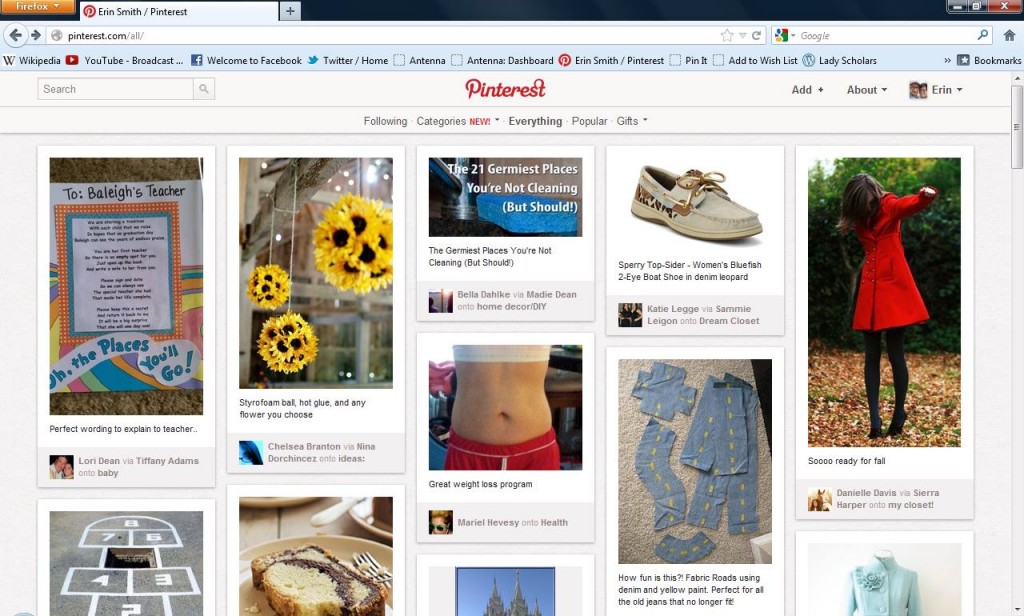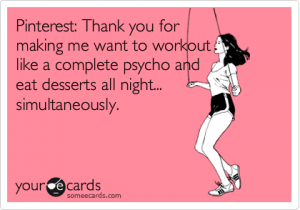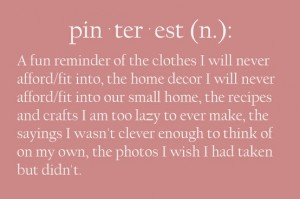Pinning Postfeminism
![]() Even if you’ve not used Pinterest, you’ve probably heard something about it, as it’s been part of the zeitgeist for awhile now. For the uninitiated, here’s the short version: Launched in 2008, Pinterest is a social media site that allows users (called “pinners”) to curate images they find online. By “pinning” these images, pinners are able to create a virtual bulletin board full of materials they find interesting or potentially useful. Pinterest is more than a bookmarking program, though–it’s a visually appealing way to survey the things you, your friends, and anonymous pinners worldwide find worthwhile. (See the screenshot of the Pinterest homepage below for a visual.) Pinterest has grown exponentially since the site’s 2008 launch. The blog Compete.com reports that by May 2012, the site had more than 20,000,000 unique visitors–up from 700,000 in May 2010.
Even if you’ve not used Pinterest, you’ve probably heard something about it, as it’s been part of the zeitgeist for awhile now. For the uninitiated, here’s the short version: Launched in 2008, Pinterest is a social media site that allows users (called “pinners”) to curate images they find online. By “pinning” these images, pinners are able to create a virtual bulletin board full of materials they find interesting or potentially useful. Pinterest is more than a bookmarking program, though–it’s a visually appealing way to survey the things you, your friends, and anonymous pinners worldwide find worthwhile. (See the screenshot of the Pinterest homepage below for a visual.) Pinterest has grown exponentially since the site’s 2008 launch. The blog Compete.com reports that by May 2012, the site had more than 20,000,000 unique visitors–up from 700,000 in May 2010.
A Visual.ly infographic highlights that 83% of American Pinterest users are women, and that the most common areas of interest for those users are crafts, special events planning, hobbies & leisure, interior design, fashion, and blogging resources. This certainly holds up in my experience, where the pins I see most often fall into those categories, along with others including exercise tips, babies/children, humor, and food/drink.
There’s a lot to say about Pinterest, but what has struck me most about the site (which I’ve used heavily for over a year) is the way that pinners perform postfeminism. As the statistics provided indicate, the vast majority of American pinners are women, and many of the most popular categories of use are ones that are coded as “feminine” in our culture. But what does femininity, as displayed on Pinterest, actually look like? Below is a screenshot of the Pinterest homepage I captured at random on a Saturday afternoon. Images of fashion appear alongside exercise and cleaning tips, DIY decorating suggestions, ideas for back-to-school, and recipes. To the casual observer, such a selection would appear to heavily reinforce dominant codes of femininity–the female pinners (note the users’ names underneath each image) are collecting ideas for keeping their homes clean and their bodies fit and well-attired. They’re focused on the parties they’ll throw, the children they’re sending back to school, and the meals they’ll prepare. But these pins only tell part of the story.

On display across Pinterest is the juxtaposition of feminist and anti-feminist ideas that comprises the heart of postfeminism. Alongside such content as exemplifies dominant notions of the feminine (crafting, cooking, cleaning, mothering, decorating) are pins that fly in the face of such ideas. Images such as those shown below (all found on Pinterest) subvert the dominant paradigm in ways that would be recognized as feminist: quotations from Madeleine Albright about the need for women to help women, images poking fun at the idea that women should obey men, or asserting that little girls have as much interest in stereotypically “boy” play as “girl” play.



 Due to juxtapositions such as these, postfeminism has caused a great deal of consternation and confusion–women understand that they’re allowed to “have it all,” but are unsure what that means or how to achieve it. The experience of using Pinterest has been described as similarly confusing. As the image at right shows, the pins displayed side-by-side on the site, and the messages embedded within them, are not only disparate but oftentimes completely contradictory.
Due to juxtapositions such as these, postfeminism has caused a great deal of consternation and confusion–women understand that they’re allowed to “have it all,” but are unsure what that means or how to achieve it. The experience of using Pinterest has been described as similarly confusing. As the image at right shows, the pins displayed side-by-side on the site, and the messages embedded within them, are not only disparate but oftentimes completely contradictory.
Blogger Jane Roper notes that Pinterest can easily make users feel inadequate. Roper writes, “Every time I go there…Pinterest inevitably reminds me of the various ways in which I am not good enough.” She includes a litany of “feminine” qualities presented on Pinterest which she lacks, suggesting that in contrast to most pinners, she is “slovenly…a boring cook/baker…a bad mother.” Tellingly, however, Roper concludes her post: “But the upside of Pinterest–or perhaps the huge, ridiculous irony–is that people also love to post gorgeous graphics … of inspirational sayings: ‘Everybody dances to their own rhythm!’ or ‘I won’t worry my life away!’ or ‘I will love myself more each day’!”
 Not only is the content on display on Pinterest exemplary of the postfeminist moment–the experience of pinners exemplifies the daily lived experience of women who encounter these mixed messages and are supposed to make meaning out of them, making the site a fascinating (if ever-changing) snapshot of contemporary ideology.
Not only is the content on display on Pinterest exemplary of the postfeminist moment–the experience of pinners exemplifies the daily lived experience of women who encounter these mixed messages and are supposed to make meaning out of them, making the site a fascinating (if ever-changing) snapshot of contemporary ideology.



This is a great post, but what interests me most about it is how it might help us conceive of the meaning of the term “curator.” There’s plenty of discussion of how the term is overused, suggesting that just because you pick out things you like, doesn’t make you a curator. However, by emphasizing the ways in which images, products and websites are juxtaposed with one another in ways that construct and reconstruct (perhaps even deconstruct?) social relations and ideologies, you demonstrate quite nicely the ways in which pinterest’s curators do work that does in fact parallel that which occurs in museums and by more traditional or professional curators.
I have never been on Pinterest, so forgive my ignorance, but I am intrigued by the sort of narrative constructed by these visuals. It seems the gaps–literal gaps in between images and metaphorical gaps developed through juxtaposition–are in fact the point of the site. When users construct this visual representation of self, do they account for the variety of ways others may read or interpret their page? Is there the potential for conscious critique within Pinterest, or does the site’s modus operandi actually work against critique by attempting to equate even starkly contradictory images?
How personal is Pinterest? I love Mabel’s question about reconsidering the meaning of the term “curator.” Is Pinterest generally used to develop an image of self? To what extent do conversations occur on Pinterest? I ask in part because I was forced into Timeline on Facebook a few weeks ago, and I never intended (or desired) to use the site to construct my visual or verbal portrait. I wanted to use it for communication. So for a newbie, I’m interested to know how Pinterest users interact and engage in conversation?
Sorry if any of these questions are far afield–I have been wondering about Pinterest for a while, so thanks for giving me a better sense of it.
Great questions, Karen! Really, Pinterest is much less about curating a particular “page” or singular representation of self. Though each pinner curates various boards, the default visuals for users are one of two types of homepage–if you go to Pinterest.com, you’ll see images pinned by pinners around the world (that’s the screenshot included in the post). If I’m logged in, however, my homepage is a collection of images pinned by those pinners I follow. I would have to go to a friend’s collection of boards to see only his/her individual pins.
In that way, though pinners certainly think about what they pin, which boards they pin it to, and what others may think of it, it’s not about curating a particular singular image in the same way as FB Timeline (to use your example).
This distinction is a little hard to explain, but easier to understand when you’ve used the site for even a short time. I encourage you to check it out–it’s incredibly easy to use and very intuitive!
You’re so right, Mabel–have you read this NYT piece? http://www.nytimes.com/2012/07/22/magazine/pinterest-tumblr-and-the-trouble-with-curation.html?_r=2&smid=fb-share –it really got me thinking about exactly these issues, particularly as “curation” in this format is often based in consumerism. Excellent point, and I’m so glad you brought it up!
i hadn’t read that piece, but i was thinking of the awl’s post which kind of rubs me the wrong way. I get what he or she is saying, but defending the practice of curating “like actual art and whatnot” can’t help but sound elitist and exclusionary (not to mention the particular association of curation with art historical knowledge and art museums, but I digress). Plus, I’m not sure that people on pinterest would quickly refer to their own practice as curation despite the site’s association with the term. I like this piece from the American Association of Museum’s magazine that came out a few years ago. http://www.aam-us.org/pubs/mn/newspin.cfm
Great post, Erin. I definitely agree with Mabel that Pinterest may be a productive space for thinking about curation and I think this links up to your phrasing of “pinners perform postfeminism.” It is striking how much everything about Pinterest mimics the postfeminist sensibility, from the actual act of pinning (which seems almost frantic to me, but I don’t do it so perhaps I’m way off) to the overwhelming aesthetic of so much visual possibility, as Roper articulates in her post on inadequacy. As pinners “perform” postfeminism, they beautifully curate the visual manifestation of have-it-all choice, empowerment, and “licensed transgressions.” I’ve not said anything here you haven’t already in your post, but the point is, I think Pinterest is an excellent site for furthering our understanding of the critical links between online spaces, consumerism, and postfeminism. Thanks for starting this conversation.
Nice piece, Erin. I think the linking of postfeminist culture and Pinterest is dead on. What I constantly find myself wondering as I use the site is how much its users see it as aspirational fantasy and how much as practical advice and consumerist choice-making. Some of my students did a small scale user study of this site this summer and seemed to find it more aspirations than anything. But I wonder about the balance between these two tendencies, and whether the site contributes to the pressure to realize the aspirational and the fantasy that is so much a part of pf culture.
That’s a great point, Elana–and a really cool project. I have many friends who have boards labeled “Tried it!” and so on, to indicate the pins they’ve actually used–but those pins seem few and far between, frankly.
It also reminds me of all the awesome blogs devoted to highlighting Pinterest fails–the frequently pinned content that ultimately doesn’t work. That adds a whole new layer of complexity–the utter awareness that (a) this stuff is mostly aspirational and (b) not anything we’ll ever try ourselves, plus (c) it probably doesn’t work, anyway.
Thanks for this piece. I’d be very interested in your thoughts on Pinterest as an expression of the relationship between third wave or postmodern feminism and consumerism.
Such a good question, and one that deserves its own post! I certainly think that the modus operandi of Pinterest is such that it is frankly nothing BUT consumerist–even the DIY projects are not exactly cheap (though they are often thriftier than buying their counterparts outright). Certainly, as I note above (and as Sarah Murray highlights in her comment), the act of pinning is performative–in the same way that conspicuous consumption is performative. This focus on consumerism is borrowed from third-wave, as you note.
I’m going to keep thinking about this, and maybe there will be a follow-up post (unless one of you other smart folks gets to it first!).
Thanks, and I would love to see a follow up post! At least from my own experience, I use Pinterest almost exclusively to catalog things I want to buy. It’s aspirational mostly -I won’t really buy them – as you and other commenters so smartly noted. That’s why this point of yours rang so true for me – “women understand that they’re allowed to “have it all,” but are unsure what that means or how to achieve it.” The fact that to “have it all” equates with “buying it all” is obviously troubling. I kept thinking about Susan Faludi’s Backlash and the idea that capitalism and commercial forces commodify feminism, or a third wave brand of it, to sell products, that ultimately are supporting anti-feminist notions, as well as the distorting of women’s economic independence in to consumer purchasing power.
though i haven’t actually been using it with any consistency, id add that one of the things i’ve used pinterest for is pinning outfits as inspiration for mornings when i have no idea what to wear. I should say though that i absolutely despise outfits pinned from polyvore and prefer to pin outfits from actual blogs. I think my distaste for polyvore speaks to both to its aspirational quality, its all about putting together outfits based on products you can buy and equally the fact that its disembodied articles of clothing that are designed for a body type that is not mine. In other words, and I think this is what some other commenters are getting at, there are differences in how we use these boards and images, but there are also differences embedded in the images themselves and their construction.
I love this post, Erin! In my world– the world of the white, middle class mom of young children– Pinterest is a staple, a common conversational shorthand, and a map for performing suburban motherhood correctly. At the pool yesterday, I talked to no fewer than 5 friends who are using the Dr. Seuss book The Places You Will Go to have heir children’s elementary school teachers write messages for their children to read long after they’re out of school. The question “what’s for dinner?” is commonly answered with “A casserole from Pinterest– check my fall food board.” My Facebook feed is full of back-to-school pictures of kids holding old-fashioned slates, the most common Pinterest- inspired photo-op of the season.
As a working mom in a neighborhood of SAHMS, Pinterest is my ticket into the club. We all showed up to school on Dr. Seuss’ birthday with elaborate treats (mine were pretzel, almond bark and M&M green egg and ham candy), and we all slavishly follow each other’s kiddo-inspired mini-Boden back-to-school boards. Pinterest in used without irony in my world, without reflection, as a tool to make our special snowflakes’ bento-boxed lunch food that much prettier.
Such a great perspective, Sarah–thank you! I myself have lots of mom friends who use Pinterest in the same way. At least three of them did the three-window picture frame “D” “A” “D” photo for Father’s Day. (I’m not explaining it very well–see this blog post (from a friend) for a visual: http://blogs.babble.com/babys-first-year-blog/2012/06/19/our-diy-fathers-day-gift/ ) By contrast, I do not know any dads either (a) using Pinterest at all (even among my male Pinterest pals, none are dads), or (b) doing crafty DIY mom’s day gifts.
I think your point here is a good contrast to Elana’s point about aspiration vs. advice/choice-making. Gah! This deserves its own post!
Should say, too, in keeping with my point in the post–even those moms who actually use Pinterest suggestions/ideas this way are probably performing postfeminism by repinning some of the subversive inspirational and/or funny content I describe above. That makes it even more (P)interesting (forgive the pun, I couldn’t resist), to my mind.
You are totally right about the subversive sentiments– but how subversive can a much-pinned Someecards really be?
My husband made me a M O M frame for Mothers Day (but he is the PTO VP, so totally breaking the mold there, too 🙂 )
Thanks for writing about Pinterest, Erin– clearly there’s lots to say about this! After my students couldn’t stop talking about it, I decided to try Pinterest out a few months ago. I came to the site thinking maybe it would be useful for my research. I could pin things relevant to web history or the 90’s dot-com bubble, and then slowly develop this little archive whenever I came across something relevant. I haven’t been very good at keeping to this, but what I found fascinating was the way that images could shed their history and take on new meanings when re-pinned and re-circulated in the Pinterest stream. One of the first things I pinned was an image of the Pets.com sock puppet mascot, which was once an iconic symbol of dot-com excess and hubris. On Pinterest, it was quickly re-pinned to boards like “things to sew” and “products I love.” Any critique of dot-com speculation and (masculine) tech start-up bravado that this image once signified was instantly re-articulated to the feminine domestic sphere, which I found both horrifying and kind of delightful.
That’s fascinating, Megan! Since we are Pinterest pals, I can say that I’ve always really appreciated the way you use the site (it’s evident to me, if not to outsiders, that you’re pinning research & teaching materials). It’s not the typical use, but it really works and it’s fun for me to see what you’re working on! Your anecdote about the abstraction of images is absolutely right-on, also–decontextualized images take on entirely new meaning, in a fascinating display of semiotics at work.